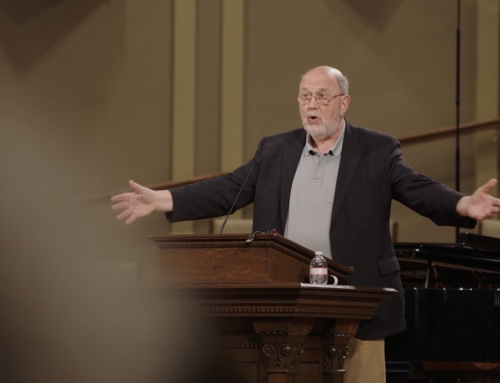![]() There are numerous differences as well as some similarities between the Gospel According to John and the Synoptic Gospels (Matthew, Mark, and Luke). This brief essay will focus on three differences (style, plot, and presentation of Jesus’ words and deeds), and three similarities (overlapping narrative arc, overlapping events, and overlapping sayings of Jesus).
There are numerous differences as well as some similarities between the Gospel According to John and the Synoptic Gospels (Matthew, Mark, and Luke). This brief essay will focus on three differences (style, plot, and presentation of Jesus’ words and deeds), and three similarities (overlapping narrative arc, overlapping events, and overlapping sayings of Jesus).
Differences Between John and the Synoptic Gospels
Style
A divergence between John’s Gospel and the Synoptic Gospels is felt immediately upon turning to John 1:1, as the first words, “in the beginning,” take readers back to the start of everything—Genesis 1:1. By contrast, Mark’s Gospel takes readers quickly to the public ministry of Jesus. Matthew’s Gospel opens with a genealogy then moves on to stories surrounding the infancy of Jesus. Luke’s Gospel provides unique details of the birth of John the Baptist as well as Jesus, before offering a genealogy (Luke 3:23-38). The Synoptic tradition wrestles early on with the human lineage of Jesus. But John’s Gospel goes back to the very beginning, describing Jesus, the Logos (“word”), as both equal to and distinct from the God of the Old Testament (“the Word was with God and the Word was God”). The entire prologue (1:1-18), functions like an overture to an opera, as John touches on themes that will be developed later in the book.
In addition to the opening picture of Jesus, another stylistic difference includes John’s dualistic language, demonstrated in contrasts such as: belief/rejection, light/darkness, truth/lie. John also connects the ministry of Jesus to the Jewish Calendar, with its various festivals, as Jesus is seen to visit Judea over a three-year period, in contrast to the one-time visit to Jerusalem as an adult (Palm Sunday), described in the Synoptics.
A divergence between John’s Gospel and the Synoptic Gospels is felt immediately. Click To TweetPlot
The three-year ministry of Jesus that John records is one example of how John’s narrative flow differs from that of the Synoptics. Noteworthy is the controversial cleansing of the temple which John records as happening early in the ministry of Jesus (Chap 2), as opposed to being part of the last week of Jesus’ life on earth as told in the Synoptics.
John’s Gospel does not recount the baptism of Jesus but describes the start of the Lord’s public ministry with the call of some disciples (1:35-51) and the turning of water to wine in Cana of Galilee (2:1-12). The first 12 chapters of John are known as the “Book of Signs,” as the Lord’s miracles (called “signs” by John) offer testimony to Jesus’ identity as the Son of God.
The “Book of Glory” (Chap 13-20) focuses on the Lord’s imminent crucifixion, featuring lengthy discourses from Jesus directed to his disciples (e.g., The Farewell discourse in Chapters 14-16, following the washing of the disciples’ feet in Chap 13, preceding the Lord’s prayer for his disciples in Chap 17).
The Presentation of Jesus’ words and deeds
Only John has Jesus making pronouncements with a double “amen” (KJV: “verily, verily”), but there are more substantive differences in the words and actions of Jesus. In John’s Gospel we don’t see Jesus perform an exorcism (but note 12:31) whereas in the Synoptics that is a major feature of the ministry of Jesus. Jesus teaches in long discourses in John, but not using many parables. John has much unique material, such as the encounters with Nicodemus (John 3) and a Samaritan woman (John 4), as well as the washing of the disciples’ feet (John 13), but not instituting the Lord’s Supper. The post-resurrection appearance to Mary Magdalene alone (John 20) is another idiosyncratic feature of John’s Gospel.
There are many more examples of John’s unique presentation of the words and deeds of Jesus, such as John being alone among the Gospels in reporting the promise of the coming paraclete (John 14-16) and the seven “I am” statements. Readers of the Gospels should explore this area more noting how John’s presentation of Jesus complements that of the Synoptics.
John is alone among the Gospels in reporting the promise of the coming paraclete and the seven 'I am' statements. Click To TweetSimilarities Between John and the Synoptic Gospels
Same basic story
After that brief examination of some of the differences, we hasten to note that there are some similarities between the Synoptics and John’s Gospel. John’s basic story is the same: Israel’s Messiah is announced by John the Baptist, teaches, works miracles, runs into conflict with religious leaders, gets arrested and tried by Jewish and Roman officials, is crucified, but is resurrected from the dead.
Overlapping events
Also, there are overlapping events between John and the Synoptics, such as: John the Baptist’s ministry, Jesus feeding of over 5000 people, Jesus walking on water, Jesus’ friendship with Mary and Martha of Bethany, and many others.
Overlapping sayings
In addition to the events, there are saying of Jesus that are shared with the Synoptics. A few examples are:
- Rebuilding the temple in three days (John 2:19//Mark 14:58)
- Prophets without honor (John 4:44//Mark 6:4)
- Receiving me and receiving the one who sent me (John 13:20//Matt 10:40)
- Predictions of betrayal (John 13:21-30, 38//Matt 14:18-22, 27-31)
Four Unique Representations
The early church concluded that we needed the four presentations of Jesus that we have in the New Testament. Each author brings a unique perspective—stylistic as well as theological—to the story of Jesus. While we can confess that John’s Gospel is significantly different from the Synoptics, we can also admit that John’s portrayal adds to our understanding of how early Christians understood the person and message of Jesus.
Renew Your Mind with these Online Courses:
![]() The course Themes in the Gospel of John explores the cultural and historical background of our era to help us apply the Gospel of John to today’s world
The course Themes in the Gospel of John explores the cultural and historical background of our era to help us apply the Gospel of John to today’s world
Sign up for a course coupon
![]() FREE COURSE – Faith Working Through Love examines a series of Biblical texts that discuss how Christians should consider the work they do
FREE COURSE – Faith Working Through Love examines a series of Biblical texts that discuss how Christians should consider the work they do
Sign up for a course coupon
![]() Understand how the writings contained in the Book of Daniel were understood in the context of the historical period of the Jews before Jesus’ day.
Understand how the writings contained in the Book of Daniel were understood in the context of the historical period of the Jews before Jesus’ day.
Sign up for a course coupon
![]() FREE COURSE: Explore the meaning of The Lord’s Prayer in the greater context of Jesus’ life and work. Develop a deeper understanding of how the Lord’s Prayer can enrich your daily life.
FREE COURSE: Explore the meaning of The Lord’s Prayer in the greater context of Jesus’ life and work. Develop a deeper understanding of how the Lord’s Prayer can enrich your daily life.
Sign up for a course coupon
Latest posts by Dennis Edwards (see all)
- Three Ways John is Different from the Synoptic Gospels (and three ways it’s similar) - September 19, 2018
- Three Ways Old Testament Theology Points to Jesus - May 15, 2018






